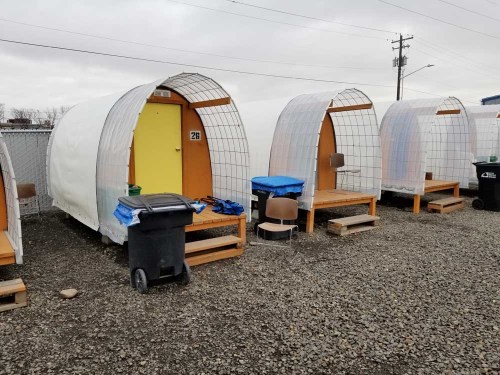Stepping Stones looks outside Hermiston after city council vote
Published 2:00 pm Wednesday, September 23, 2020

- A new Hermiston nonprofit, known as Stepping Stones, has proposed a homeless shelter in Hermiston modeled after the sleep center in Walla Walla, Wash., run by the Walla Walla Alliance for the Homeless, pictured here.
HERMISTON — The board for a local nonprofit says it is committed to looking for a new location for its proposed homeless shelter after the Hermiston City Council passed an ordinance on Monday, Sept. 14, that banned shelters within 1,000 feet of parks and schools.
Cathy Lloyd, board president for the newly formed nonprofit Stepping Stones, said while the ordinance technically allows for temporary emergency shelters like the one proposed, regulations in the ordinance — particularly the 1,000 foot rule and a requirement the shelter must be co-located with an existing use on industrial property rather than having its own property — means the board will be looking outside city limits for space.
“We sat and looked at the city’s map and there’s not anything available,” she said. “It’s pretty disappointing.”
She said the next steps were to look for possible sites located in the county or a nearby city, and look into zoning rules in those areas.
The Stepping Stones board has proposed a shelter modeled after shelters in Walla Walla, Washington, and elsewhere that use small Conestoga huts to shelter homeless individuals. The huts do not have running water, electricity or other amenities because they are not meant to be seen as a permanent housing option, but they do provide more privacy and storage than a warming station with cots lined up on a floor.
The board has stated that guests would only be allowed into the property at night after checking in with a volunteer, and paid security and security cameras would monitor the site. Once the shelter was up and running, Stepping Stones planned to implement a requirement that guests must earn credits to extend their stay through work, volunteering, education or other things that could help them escape homelessness.
Stepping Stones had hoped to place the camp on a piece of property behind the Agape House, allowing guests to access showers, emergency food boxes and other assistance at the site. But some neighboring property owners and area residents testified they were worried that the project would result in additional loitering, littering, theft and other crime in the area, including nearby Theater Sports Park.
“The warming station existed for two years at the Arc building in the middle of a park, in between two schools, and that wasn’t a problem then,” Lloyd said.
She also noted that property owners had stated that things like littering were already a problem there without the shelter, and the shelter’s board had planned to do regular cleanups around there. She said they had hoped, since a shelter would be a conditional use that the planning commission would need to approve a permit for each year, that people would at least give it a chance to operate for a year.
“Let’s see if there is a problem,” she said.
The planning commission proposed a blanket ban on shelters near parks and schools, however, and the city council passed the ordinance as recommended by the commission.
“We’re still in it for the long run, but frankly, we feel that with the step the city took with the ordinance, and the way it was worded, they are showing they are not interested in working on the project,” she said.
Stepping Stones had already done outreach for the proposed project and Lloyd said some of the organizations in the area that serve low-income residents had expressed an interest in a partnership. She said since the city council’s decision they have heard from a “pretty sizable list” of people who have said they were still interested in supporting the project if it found a home outside city limits. She said the Stepping Stones board was still fully committed to finding a way to make the project work.
“I asked (the board) frankly, ‘Are you guys done? What do you want to do?’ I thought there would be more discussion, but everyone was like, ‘Absolutely, let’s move ahead,’” Lloyd said.
She said since the members of the board all live on the west end of Umatilla County, that’s where they would prefer to locate the project.









